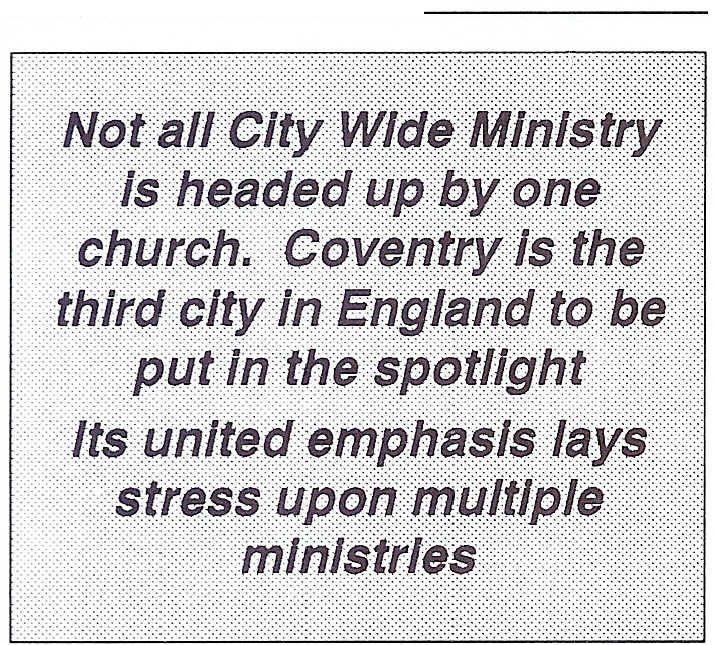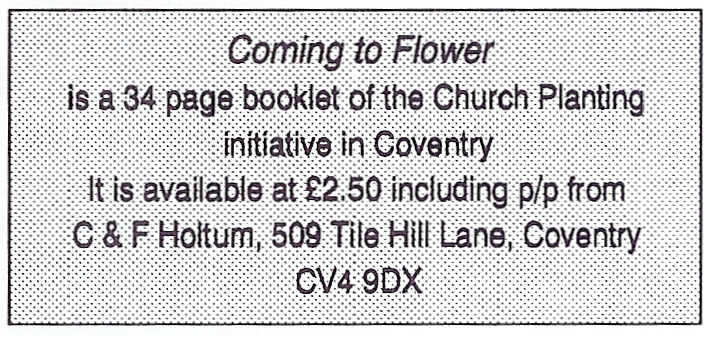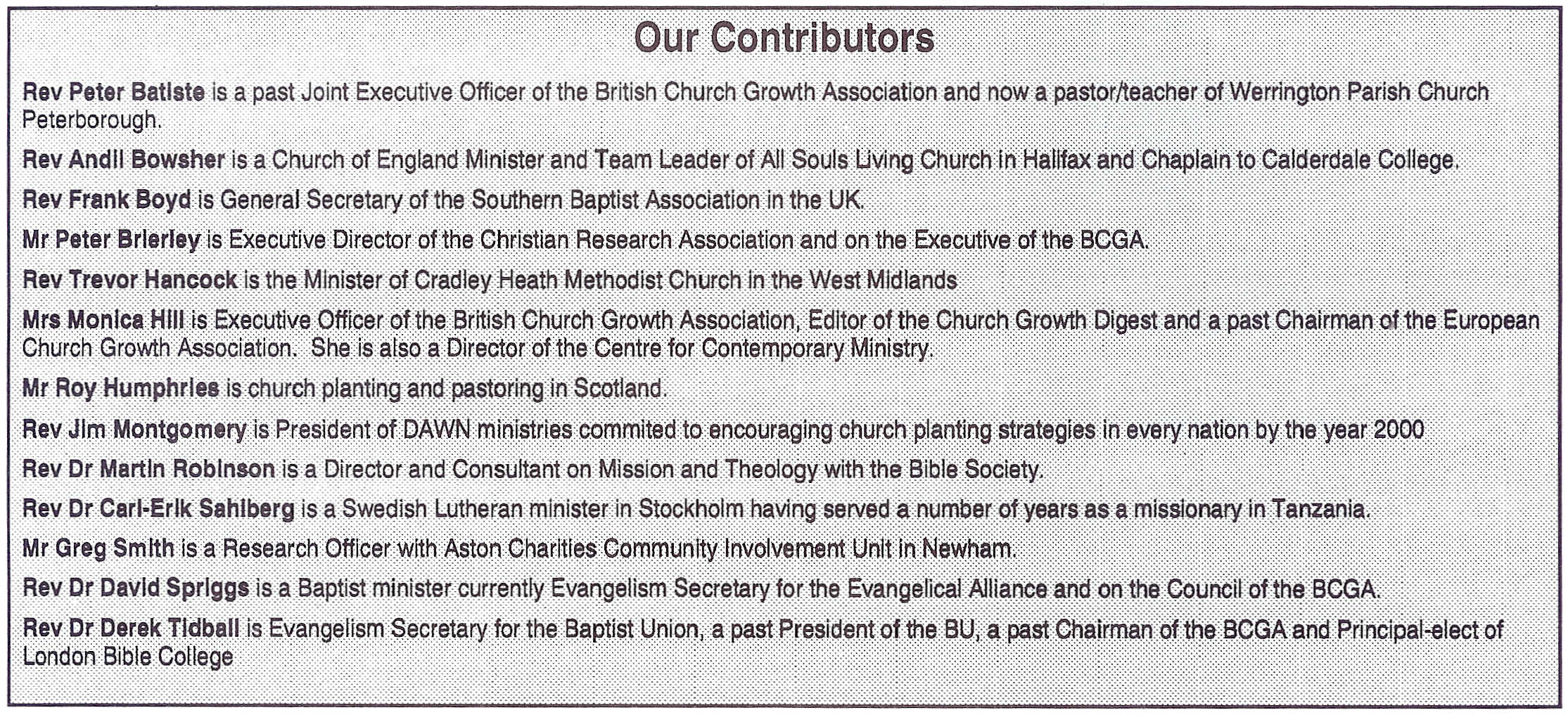
Urban Leadership Foundation
A hub for leadership training in cities and among the world's 1.4 billion slum-dwellers
CITY WIDE CHURCH DEBATE
Coventry
-David Spriggs

Coventry is a medium-sized city in British terms. Its population, although slightly in decline at the moment, has hovered around
300,000
for the last two decades. In the 1950s and 60s it was a boom town, experiencing
significant expansion and boasting the highest paid 'blue collar' jobs.
Its commitment to modernity is expressed in its pedestrianized shopping precinct which when it was opened in the 1950s was one of the first in the country and also in its avant garde cathedral. Both of these now begin to fade and need repairs! Alongside the new cathedral are the ruins of the old one, reminding all of the savage bombing raids Coventry experienced during the war. However, those ruins are a powerful symbol too of first the spirit, and then the ministry, of reconciliation which has developed from the commitment to forgiveness.
As the shopping precinct and cathedral mirror a secular and spiritual commitment to modernity, so the spiritual ministry of reconciliation is mirrored in the civic commitment to twinning arrangements with cities and towns all around the world. This is no superficial gesture for Coventry has received and, on the whole, welcomed waves of immigrants: the Welsh to the mines in the 20s and 30s; the Irish builders to resource the expansion; Caribbeans, and
last, but by no means least - the
Ugandan Asians.
One other secular feature seems mirrored in the spiritual arena. Coventry has a very efficient inner ring road system, which inadvertently but effectively segregates the centre from the people, especially at night. Although all roads lead to the centre like the spokes of a wheel, they lead in some ways to a social desert. Churches find it hard to flourish within the ring road, and routes across the city are difficult and complex. Perhaps this is why there are several reasonably large, and reasonably flourishing, churches but no mega-church even beginning to develop.
City Wide Network
Perhaps this too is why the form in which city wide vision is being expressed is very much a networking process, somewhat untidy with several major strands linked by good relationships - a spiritual expression of the road system. Certainly this is how the present scene in Coventry is best perceived. It is helpful to deal with the various arterial routes in chronological order. As we consider each one I will also indicate something of its function in the present context.
There are about 150 churches in Coventry from a number of numerically strong Roman Catholic churches to a number of Exclusive Brethren meetings, which when they gather together probably represent the largest single congregation in the Coventry Area! There are also several new church 'plants' which offer a variety of models. It is vital to understand that functions and inter-relationships are in flux all the time, primarily because of the change of key leaders as they come and go, or as they re-assess priorities and commitments.
Here then is my analysis of the key features in the Coventry City Wide Ministry.
1. Coventry Council of Churches
This was first on the scene and came to life in the 1950s. It provides a City-wide forum but also operates in about ten area councils. City-wide it has spawned the Coventry Churches Housing Association (which now works throughout the Midlands!) and more recently dealt with the issue of homelessness.
During Holy Week it organises a cooperative evangelistic presence in the centre of the shopping precinct. For several years it has organised a 'Pentecost Picnic' - a precursor of 'On Fire'. I was involved with Social Services in a city-wide approach seeking to develop cooperation between the churches and Social Services etc. This is the historic source of city wide ministry but now provides under-girding rather than being the creative leader.
2. Focus on Renewal
This provided a gathering point and encouragement for charismatic renewal when it began about 20 years ago. It has been restructured to emphasize teaching on strategic issues, as well as worship. Many of the larger and more active churches would be charismatic in style, so it fulfilled its initial role well.
3. Warwickshire
Coventry Mission Committee
This has continued since Mission England days. It organises and encourages evangelistic events. It has contributed to training people for evangelism and nurture too. It is a key organisation for central networking. Its constituents are from the more evangelical end of the spectrum, although it does include a High Church charismatic.
4. Youth for Christ
This has two full time workers and is effective in schools work and in supporting churches in localised ministry to youth, particularly those on the streets. It also supports THE BEAT, a monthly youth culture service which serves the city and attracts between 200 and 300 young people.
5. Coventry City Mission
This has three full time workers. Although located in a difficult housing estate in the north of the city, it has a city-wide ministry as well. It works through training, involving people on a voluntary basis in its work, including city centre Evangelism and Crosslines a telephone counselling service for the city.
6. The Lighthouse.
A city-wide Christian care and counselling service with three full-time and one part-time worker, plus volunteers. They are very
involved in training and resourcing
-
including the setting up of similar services beyond Coventry. They notionally offer services to Christians; for about one-third of their clients are uncommitted. They also draw people together by training, after which they are often deployed in their local church.
7. Christian Training Programme
This runs and promotes a wide range of Christian training, from day to ten-week (1 night per week) courses and is attempting to set up a year of training with CCM in evangelism. It has a half-time worker now, Rev Tony Bradley, who networks in with Anglican lay training too! CTP also
integrates with Focus on Renewal. CTP's bulletin advertises courses run by other people eg The Lighthouse and CCM.
8. March for Jesus
This group has been important in this
process. It is led by Dave Buller, who also initiates other prayer events,
eg a
Quarterly Day of Prayer
for Revival, the EA Prayer Week Celebration event. Dave is
also building
a
prayer base for the Church
Planting movement, including bi-monthly gatherings for intercessors.
9. 'The Group of 7'
About six years
ago the Reverend Graham
Dow, who at the
time was Vicar of Holy
Trinity, the city-centre Anglican Church, called together seven ministers who he felt
had a
city-wide vision. They met to pray, strategize, plan etc but also to support each other. The personnel
has
changed slightly. Graham became Bishop of Willsden
and I
have joined the Evangelical
Alliance, but we still keep
in
touch.
10. Church Planting Network
This
was initiated about five years
ago. It has a gathering about
every three months;
runs
a two-day
Teaching Conference each year, and has two part-time researchers. It now has about forty core members who are
leaders in local churches. It seeks
to train,
support and coordinate those with
a
commitment to Church Planting. Its members are moving towards cooperation in specific church plants
as
well as co-ordinating
local church initiatives.
11. Leaders' Prayer Breakfast
These
are held once
a
month giving leaders the opportunity to share information and prayer together. It is open to non-ordained leaders.
12. Celebration Events
From time to time celebration events are
organised
-perhaps for 'kids'
with
Ishmael
(organised by Coventry City Mission) or adults (organised by Coventry Christian Fellowship).
Apart from the 'Exclusives' nearly every church would be involved, through their leaders or member participation
in
events,
to a
greater or lesser extent. The weakness in the set-up is focusing all the energy of the churches in any direction - it is impossible! The strength is the comprehensiveness and variety. The Church Planting Network is probably becoming the keystone group.
How does this work?
That
it
works at all is, perhaps,
a
mystery
because apart from the Council of Churches there is no formal structure. Typically, however, any key person will network with at least two other groups.
eg: Maurice Markham: 'Group
of 7';
Mission Committee; CTP; Leaders' Prayer Breakfast; Church Planting Network. He
also has in his church key leaders
in
other groups
eg 'Youth for Christ'.
eg David Spriggs:
City-wide Council of Churches; Mission Committee; Coventry City Mission; CTP; The Lighthouse; 'The Group of 7'; Church Planting Network. I would also attend other events,
eg prayer, celebration etc.
eg Mike Steward: Chairman of Mission Committee; worker with CCM; Leaders' Prayer Breakfasts; Church Planting etc.
No one person is involved in all the possibilities. Each key person leads somewhere and follows somewhere else
-
there is no competition for power,
but a
real servant approach.
In recent years the key groups for central networking,
and
hence holding the whole process together, are:
Prior to 1980
Council of Churches
1984 - 1990
Warwickshire & Coventry Mission Committee
1990
-
1994
'Group
of 7'
1994
-
The Church Planting
Network Where and how things will develop in the future remains very much in the hands of God, although it should be noted that British Youth For Christ are intending to pilot their new mega-mission concept in Coventry and Warwickshire. Will this mean the Youth Front will become
a focal
point?


Church Growth Digest Volume 16 Number 2
© Viv Grigg
and the Encarnação Alliance Training Commission
For problems or questions regarding this web contact
web@urbanleaders.org
Last updated: 05/15/09.